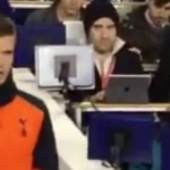Since January of last season, when a training ground bust-up with Antonio Conte went public, it has been evident that Diego Costa was destined for a Chelsea exit. And, albeit later than expected, his return to Atlético Madrid has now been confirmed – although he’ll have to wait until January to make his second debut for the club due to a registration ban.
He ultimately proved to be as much of a nuisance to Conte as he was to Premier League defenders during his three years in England, but few would question the quality the Brazil-born Spain international brought to west London, where he spearheaded two title triumphs in three seasons.
Yet Conte had no qualms about ditching the man who top-scored for the champions last term with 20 league goals, because he knew that in Álvaro Morata, a club-record £65m summer signing from Real Madrid, he had found a striker not only capable of replacing Costa, but exceeding him, too.
Doubts were raised over the 24-year-old’s ability to lead the line as a first-choice No.9 at a major club, and his temperament to deal with the burden of expectation. Last season, he had to play second fiddle to Karim Benzema in the Madrid attack, and his role at Juventus during his two seasons in Turin was mostly a supportive one.
Indeed, last term was the first in which he reached the 20-goal mark in all competitions, but his quick adaptation to life in the Premier League - and his apparent relish at being entrusted with a lead role in an elite side - is testament to his readiness for the move to Chelsea.
The signs were there last season, too. Although Morata had to content himself with a secondary role in the most important matches, he was chomping at the bit to be more regularly involved, hence his eventual desire to leave the club he grew up supporting in search of key-player status elsewhere. The developmental leaps he made – further finessing his intelligent movement and drastically improving his finishing technique – gave cause for some to contest that Madrid should have put faith in the 22-cap La Roja star, even at Benzema’s expense.
Despite never securing a regular run of starts, and thus not benefiting from the continuity of form that comes with it, Morata’s average of a goal every 89 minutes in La Liga was bettered only by Lionel Messi in 2016/17, and his conversion rate of 27.27 per cent demonstrated a new ruthlessness than not even Premier League top scorer Harry Kane could match (26.26 per cent). Likewise, Costa’s averages (a goal every 154.5 minutes and a conversion rate of 18.02 per cent) fall some way short. Rather than Morata being unable to deliver 30-plus goals a season, it seems it was simply that he had never been given the chance.
But Costa’s game, and his value to Chelsea, has always been about more than just goals. As the bludgeoning battering ram of the Blues’ attack, the former Rayo Vallecano loanee could be sought in high areas and trusted to hold the ball and link with supporting team-mates, while his selfless work in pressing and running channels opened space for those around him; it wasn’t always pretty, but Costa’s style was incredibly effective.
Stylistically, Morata differs greatly. The Spaniard has a unique grace to his game: he glides along the turf like an ice hockey puck sliding across a freshly Zamboni’d rink, whereas Costa scurries around, all bustle and elbows. But the ex-Juventus star is similarly cognisant of assisting his colleagues, and his work ethic is unquestionable.
With more strings to his bow than Costa, Morata is also able to hurt the opposition in a greater variety of ways, scoring from a multitude of angles in various scenarios. The second goal of his recent hat-trick against Stoke City is evidence of this – the kind of strike his predecessor would’ve been unable to conjure.

In the above image, we see Morata receive the ball inside his own half, marked tightly by Stoke defender Bruno Martins Indi. The Chelsea striker spins away from the Dutchman, utilising the kind of speed and dribbling ability Costa is not able to call upon.

Breaking forward at pace, he makes a beeline for goal, seeing of a challenge from Darren Fletcher thanks to his raw speed and faultless close control while in motion.

Through on goal, he finishes calmly, lifting the ball beyond the sprawling goalkeeper and into the far corner.
At 6ft 2in Morata is the same height as Costa, but the new hero of Stamford Bridge is much more effective in the air, and has already scored more headed goals for the Blues in the Premier League this season (three) than Costa managed in the whole of 2016/17 (two).

Above, against Leicester, we see how Morata’s all-round mastery of the aerial game is key to his prowess in such situations. As the ball is worked wide to César Azpilicueta on the right, and the Spanish defender prepares to cross, the Chelsea No.9 is already plotting his attack, pulling onto the shoulder of Wes Morgan, moving into the powerful centre-back’s blind spot.

When the ball arrives in the area, Morata exhibits tremendous athleticism to leap high above Morgan – no slouch in the air himself – and the technique to accurately guide his header into the bottom corner.
The main aspect of Costa’s game that most believe will be sorely missed at Chelsea is his tenacity and physicality. Few players can match the Lagarto-born striker’s combativeness, but Morata has been wrongly characterised as some kind of soft touch; he is capable of showing aggression when the time is right.

In the above image, taken from Chelsea’s 2-1 Champions League victory away to Atlético, Morata’s blocked attempt at a lofted through-ball threatens to extinguish the Premier League side’s progress.

However, almost angered by the temerity of Diego Godín in thwarting his creative effort, Morata instantly chases down the Uruguayan defender and out-muscles the Atleti man to regain possession.

Once he has the ball back at his feet, Morata is coolness personified as he raises his head, spots the run of N’Golo Kanté and picks out the French midfielder inside the penalty area.
Collective wisdom may suggest Conte’s first choice for a new striker this summer was Romelu Lukaku, the former Chelsea youngster who ended up moving from Everton to Manchester United in a £75m deal, which was seen by many as an embarrassing loss for the Blues.
But in Morata they have secured a better stylistic fit for Conte’s system; a modern, all-round striker whose potential is waiting to be tapped into.















